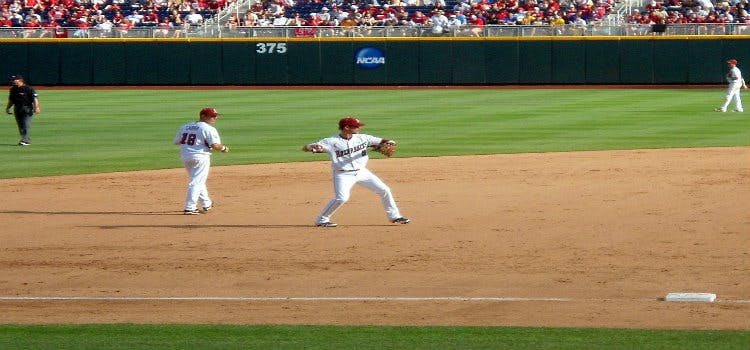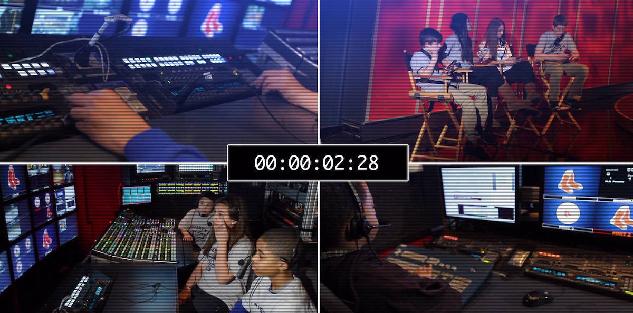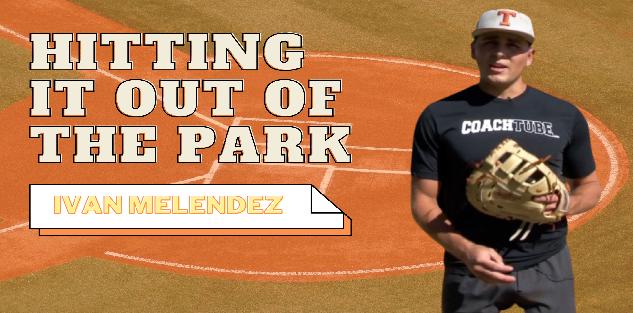Featured courses
- Understanding The Shift by Brandon Ogle
- Two Drills to Improve Outfield Movement and Communication by Grant Young
- The Ultimate Resource For Coaching Youth Baseball by Jackson Chlebowy
- Become a Master at Bunting by Brandon Ogle
- 5 Reasons Why There Is More To Good Base Running Than Just Speed by Brandon Ogle
- Three Injury-Prevention Tips For Your Offseason Pitching Program by Grant Young
- How to Teach Hitting to the Next Generation by Grant Young
- Developing Defensive-Minded Baseball Catchers by Grant Young
- 3 Baserunning Tips to Score More Runs in Baseball by Grant Young
- 5 Outfield Drills to Work on in Season by Alec Burris
- Keys For Scoring More With Runners on First and Third Base by Grant Young
- How to Develop Your Game to Become a Five-Tool Player by Brandon Ogle
- 3 Coaches Share the Keys to Running Baseball Practice the Right Way by Grant Young
- Four Drills to Sharpen a Baseball Hitter’s Vision at the Plate by Grant Young
- Four Quotes to Hit Better With Two-Strikes by Grant Young
- Four of Former MLB Pitcher Juan Nieves’ Movement-Based Pitching Drills by Grant Young
- Two Tips For Developing an Elite Baseball Bullpen by Grant Young
- Overcoming the Four Challenges of Indoor Baseball Practices Because of Weather by Grant Young
- Three Tips to Make Your Baseball Team Mentally Tougher by Grant Young
- Three Priceless Philosophies to Motivate Your Baseball Team by Grant Young
- Three Offseason Baseball Drills to Simulate Competition by Grant Young
- Three Baseball Offseason Strength and Conditioning Essentials by Grant Young
- Important Ways to Improve Your Baseball Team’s Baserunning by Grant Young
- Three Ways to Perfect Hitting Mechanics From an MLB Icon by Grant Young
- Catchers can influence pitchers...for bad or good by Drew Johnson
- Throwing Strikes and Playing Good Defense Equals Wins by Jose Ortiz
- Legendary Indiana Head Baseball Coach Bob Morgan’s Offensive Theory by Grant Young
- Tennessee Head Baseball Coach Tony Vitello on How to Practice Baserunning by Grant Young
- Three Great T-Ball Drills For Youth Baseball Players by Grant Young
- How to Manage a Baseball Pitching Staff by Grant Young
- Three Uncommon Tips to Become a Better Hitter by Grant Young
- How a Baseball Coach Can Develop Strike Throwers by Grant Young
- Drills to Develop Elite Baseball Outfielders by Grant Young
- Baseball Training Exercises to Strengthen Arm and Bat Speed by Grant Young
- How to Use Bunting to Score More Runs by Grant Young
- How To Build An Elite Baseball Infielder by Grant Young
- Three Drills to Improve Your Baseball Team's Infield Play by Grant Young
- Three Keys to Curating a Pitching Staff’s Success by Grant Young
- 3 Techniques to Develop a Baseball Player’s Hitting Approach by Grant Young
- How to Cultivate Confidence Within Your Pitchers by Grant Young
- 5 Every Day Drills To Help You Become A Better Catcher by tyler Linderman
- How to Throw A Curveball by Brandon Ogle
- How to Assemble a Lock-Down Bullpen by Brandon Ogle
- How to Throw a Sinker by Brandon Ogle
- How to be a Smart Baserunner by Brandon Ogle
- Improving a player's slugging average by Phillip Woolgar
- The 8 Fundamentals of Pitching by Drew Johnson
- How to Throw a Deceiving Changeup by Brandon Ogle
- Step Up Your Outfield Defense With These Three Drills by Jose Ortiz
- 8 Baseball Drills Every Player Should Practice by Drew Johnson
- How To Become An Elite Defensive Outfielder by Tyler Linderman
- 5 Tips For Crushing A Curveball by Johnny Grassi
- LEGENDS FOR YOUTH INCLUSION BASEBALL CLINIC by Phil
- Fourteen Ways To Turn A .300 Hitter Into A .210 Hitter by Jay P. Granat, Ph.D.
- How To Become The Ideal Leadoff Man by Brandon Ogle

8 Baseball Drills Every Player Should Practice
- By Drew Johnson
The old saying that “defense wins championships” doesn’t just apply to the gridiron. Last year, the Houston Astros led the MLB in Defensive Wins Above Replacement. Not surprisingly, they made it all the way to the World Series. Your team isn’t playing in front of thousands, but the games are still important. In big games, every play counts, and your infielders have to be able to field their position. Defensive excellence starts in practice, and here are 5 tips to get your infield ready for the big game.
1: Game Speed Matters
If you practice with low energy, you’ll play with low energy. As a coach, the level of intensity starts with you. Are we saying that you need to scream when your second baseman boots a two-hopper? Of course not, but fielding routine ground balls every day never helped anyone. Add a little “umph” on those grounders and give your fielders a challenge. What’s the most important fielding drill you can practice with your players? Making them play each practice ground ball like a game ground ball.
2: Work The Backhand
It’s simple: the ability to field a ball backhanded allows a player to quickly get to more balls. Keep an eye on how many balls your infield boots next practice. I’d bet that most of them were hit to the backhand. If you don’t practice it, your players will never make the backhanded play. It takes flexibility and a weight-shift that’s unique in the game. When your shortstop can go to his right, backhand a ball, and make the throw, that’s when you know your infield is clicking.
Here Coach Bob Morgan, former head coach of Indiana University, explain the backhand drill for middle infielders.
Source: Infield Play: Drills & Techniques For Infielders
3: Short hops, Short hops, Short hops
When we think of short hops, usually we envision working with the first baseman. However, fielding short hops takes soft hands - a trait that we want every one of our infielders to have- and occurs much more than just on throws to first.
Pair the kids off and make them throw short hops to each other. Next time your second baseman picks one up and lays down a tag to get the runner, you’ll thank us.
4: Bunt Drills
We know… bunt drills are tedious.
As a second baseman, I hated bunt drills. I’d jog to first, stand over there to field the throws, or even make a back-up do it. But, a bunt can change the dynamic of a game. They usually take place in close games, and if your team isn’t ready to defend the bunt, you can turn a free out into a two base error. Bunt drills need to be practiced every single day. Your second baseman might be upset with you, but at least he’ll be in really great shape.
5: Like a Big Leaguer
Your team can do all the drills, learn all of the fundamentals, and have a perfect “ready” stance, but if they’re not comfortable in the field, they’re going to make errors. My favorite drill of all time is the “Big Leaguer.” Basically, your team fields balls and makes the throw to first while trying to look as good as possible. Maybe it’s a little dance before they get in the ready position or maybe they sidearm a throw to first Let your guys show off a little bit, and have a little swagger; it will get them more comfortable when they’re on the diamond. They’ll know when to “turn it on” for game time.
6: Long and Short
Many games are decided by the 50/50 balls- the grounder in the hole to the shortstop or the swinging bunt that the third baseman has to field barehanded. In this drill, you prepare your team to make those 50/50 balls.
First, hit a ball deep in the hole and let your infielders work on their lateral movement. After they make the throw to first, have them charge another softly-hit ball and make another throw to first. You’ll see some coaches have their kids make one of the throws to home plate, but it’s really just preference.
7: Rolling Two
Turning a double play can completely change the course of an inning and even change the outcome of the game. When you need your middle infielders to work their magic, make sure that you’ve prepared them for it.
I’d suggest that you practice turning double plays during every infield practice, hitting grounders to each of your infielders and letting your second baseman and shortstop make the turn. Keep an eye out on your middle infielder’s feet- make sure they’re hitting the bag and getting out of the way of the incoming runner.
8: Covering First
This one is for your pitchers and your first baseman. Let your pitchers go through their motions, and respond by hitting a ground ball to first. The first baseman fields the ball and tosses the ball to the pitcher who is covering first for the out. Some key things to remember here:
●You want your pitcher to run parallel to the first baseline, not directly to the bag.
●You also want to train your pitcher to hit the inside of the first base bag, to keep them safe from injuries.
●Let’s be honest, your first baseman might not be the most graceful player on the field. Don’t train him to try to make the perfect, soft toss to your pitcher. Train your first baseman to get the pitcher the ball and then allow him to run to the base.
How do you make your infielders better? You practice like you play, you work on the fundamentals, you prepare for every play, and you help them stay comfortable on the field. The momentum starts with you, coach.
During your next practice, implement some of these strategies: liven up the practice with some hard-hit balls, get back to basics, and let the kids have fun- even when they’re taking ground balls. When sound fundamentals meet preparation and confidence, success will always follow.
So get out there, and help make the next Ozzie Smith great!



